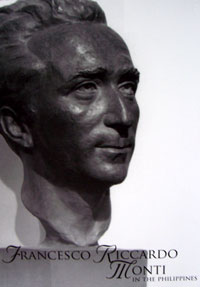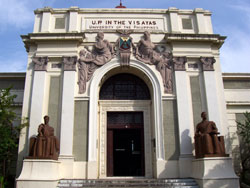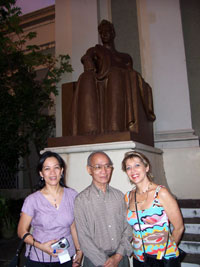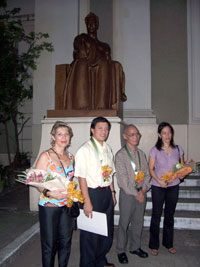An Italian sculptor's legacy in the Philippines

A visual art exhibition is currently on show at the University of the Philippines in the Visayas (UPV) Art Gallery on the works of Italian sculptor Francesco Riccardo Monti (1888-1958). This exhibit which opened last Friday, November 11, 2005 features well-mounted black and white photographs of the large scale sculptural pieces done by Monti during his stay in the Philippines for almost three decades (1930-1958). The guests of honor at the opening were gallery owner, art leader and initiator of this Monti project, Ms. Sylvana Ancellotti Diaz and Mr. Timoteo Jumayao, a visual artist from Pavia, Iloilo who was a former student of Monti at the University of Santo Tomas.
Why the fuss over an import, a sculptor from Cremona, Italy? No, this is not colonial mentality all over again. The man is not being honored because of his Caucasian race but rightfully because of his selfless contribution to enriching Philippine art. Prior to the conception of this research project that culminated in this exhibit, very little was written about Monti in Philippine art history books; his works were relatively unknown and unappreciated. The research project unearthed valuable evidence of his contribution to the development of the sculptural arts in the Philippines. As Prof. Ma. Victoria Herrera, the project's coordinator and exhibition curator says, 'His (Monti's) works represent not only an individual's achievements but also a significant phase in the production of large-scale and outdoor sculptures in the Philippines in the first half of the 20th century.'

The bas relief of four figures above the main
doorway and the larger-than-life statues guarding
the entrance of the UPV Iloilo City Campus, formerly
Iloilo City Hall, are magnificent creations of Monti.
Monti sculpted the huge figures on top of the University of Santo Tomas (UST) Main Building, the sculptures at the Metropolitan Theater of Manila, and those at the Sto.Domingo Church, to name a few. What will probably surprise many is that Monti also left his mark in Iloilo and Bacolod. The UP in the Visayas Main Building (formerly the Iloilo City Hall) at Infante, Molo, which currently houses the Monti exhibit actually contains outstanding Monti sculptures.
Monti found his way to Iloilo and Bacolod because of his good friend, Juan Arellano, Consulting Architect of the Bureau of Public Works in the mid-1930s. Juan Arellano (declared National Artist for Architecture) designed the Iloilo City Hall that was inaugurated in 1936 as well as the Negros Occidental Provincial Capitol Building inaugurated in 1934. In both of these projects, Arellano tapped the services of Monti to create public sculptures befitting these civic buildings.

Prof. Ma. Victoria Herrera, Timoteo Jamayao
and Sylvana Ancellotti Diaz.
For the Iloilo City Hall, the bas relief of four figures above the main doorway and the larger-than-life statues guarding the entrance were designed by Monti. One can even find his signature incised at the base of these allegorical statues, Law and Order, the 'entrance guards' often mistaken as Plato and Aristotle. An interesting discovery is that Monti was assisted by Ilonggo sculptors from Molo like the Sabiano brothers of San Juan and Juan Siendo of North Fundidor who had in his employment Quintin Marañon, Manuel Pandes, a certain Cano and Santiago.
For the Capitol Lagoon in Bacolod, Monti was responsible for what Negrenses nonchalantly refer to as the 'carabao.' That imposing sculpture of a carabao with a woman holding a sugarcane stalk is actually known by many titles: 'Homage to Agriculture', 'Filipina Agriculturist' or 'Allegoric Sculpture for Fountain.' Monti intended it as a fountain, with water spewing forth from the carabao's mouth. Clearly, this public sculpture is a symbolic representation of the importance of agriculture in the Philippines and the significant contribution of Negros Occidental to the economy.

Some of the guests during the opening of
exhibit.
To get a complete picture of who Monti is and what he has done in and for the Philippines, one must visit this visual art exhibition--a product of painstaking art historical research and documentation, first-rate exhibit design and sound curatorship.
The Monti exhibit will run until December 2, 2005. The Gallery is open Mondays to Fridays from 8:00-12:00 a.m. & 1:00-5:00 p.m.
